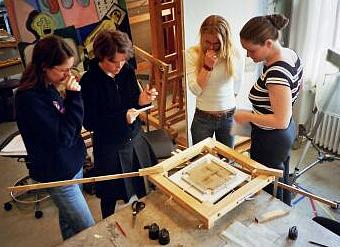
 |
Introduction |
This web site is a loosely organised compendium of lectures, published articles and informal tutorials, accumulated since the first images could be put on the World Wide Web. There is considerable repetition but often repeating concepts in a different context helps understanding.
I decided that I did not know enough to write about the whole subject of conservation physics but I knew some things that others might find useful. There must be many people in this position. Their contributions are usually in volumes of conference procedings, hidden among articles on completely different subjects. Many contributions are still hidden in the minds and hands of people who are not part of the relatively tiny group of conservators who build their careers on scientific publishing. We really should be better at distributing technical and scientific knowledge, now that the internet has the power to deliver information almost without cost to anyone in the world.
Another motive for writing is my belief that conservators are exposed during their training to analytical techniques of an intricacy and expense which ensures that they will never use them again in their careers, whereas an understanding of the physical principles of mechanics, microclimate and illumination can be put to use every working day. To illustrate this assertion I show a picture of four of our young generation of painting restorers in training at the Copenhagen Conservation School, studying the properties of a relining textile for rescuing crumbling old art on canvas.

Katja , Loa, Anja and Tanja (from left to right) look with some puzzlement at this apparatus for studying the stress-strain response of the relining material. They were even more puzzled when they had finished the experiment and found that the polyester relining material was considerably more elastic than the painted linen canvas they were intending to laminate to it, so that after lamination, the original canvas would be supporting the new canvas, rather than enjoying a relaxed semi-retirement. The polyester fabric is a product from a well known conservation materials supplier.
The experimental apparatus took a day or two to make from scraps of wood and bits of yacht rigging. It is an example of how a little physics can get a conservator much further than an equivalent amount of study in chemistry. The apparatus would have been immediately understood by Galileo, who would no doubt have designed some improvements. The next time you stand impatiently in the queue to enter the Uffizi Gallery in Florence, avoid the crowds and visit the Museum of the History of Science, just round the corner. Here is Galileo's apparatus and here you may sense more strongly than in the Uffizi the foundations of our modern world.
I have been helped in writing this material by the indulgence of the three museums which have allowed me to pursue interesting investigations further than was strictly necessary. The Victoria and Albert Museum, The Smithsonian Institution and the National Museum of Denmark. The Danish Ministry of Culture has contributed to the work of ordering the diverse and overlapping material into some semblance of an orderly progression. Many collaborators are mentioned at appropriate places in the text.

This work is licensed under a Creative Commons Attribution-Noncommercial-No Derivative Works 3.0 License.